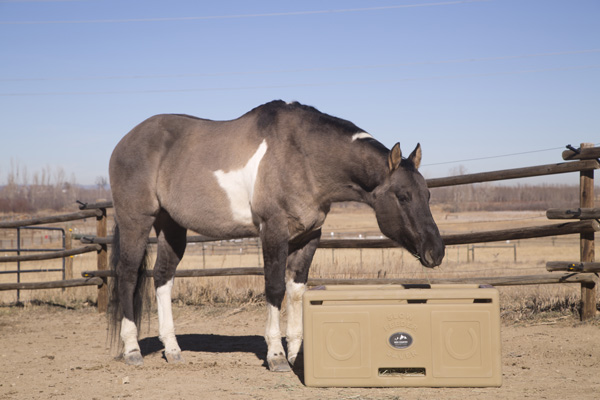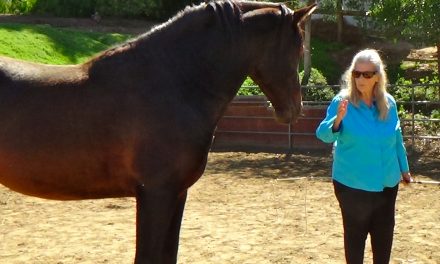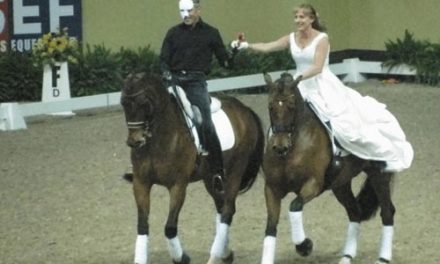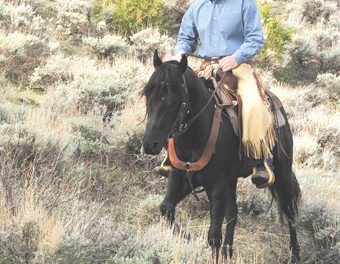Notes From Julie

Make sure your horse is calm and relaxed before offering him his dinner. Note that feeding by free choice can help calm feed-time anxiety. Photo by Heidi Melocco, Whole-Picture.com
Q: Help! What do I do, my horses are crowding me when I go into their pen to feed them and it’s just scary to have them so close and on top of me. Plus, I want my husband to help with feeding, but having the horses so pushy and not allowing you space to get from the gate to their feeders is making him too scared to help with chores. What do I do? —Kate Brenday, Alabama
Julie’s Answer: Entering a pen full of horses, even just to catch one can be quite risky and at feed time, it can get really dangerous! You are smart to be afraid– interactions between dominant horses and their subordinates can be lightning quick and very violent and you don’t want to be caught in the middle of that. Often, with large groups of horses, the herd dynamics escalate fast and the horse that is trying to get away from another aggressive horse can easily run right over the top of you.
Not only that, but one way in which horses establish dominance in the herd is to take away food from other horses, so food aggression is common, especially if the horses are only fed once or twice a day and go stretches with no food. If you walk into a pen full of horses with feed and they are crowding you and trying to attack the food, it is incredibly dangerous and your horses have no manners and little regard for your authority or well-being.
Sometimes unsafe food-based aggressive behaviors can develop even if you don’t go into the pen with the horses to feed them. Often handlers will ignore the aggressive gestures of the stressed-out horse and drop the feed over the fence into the pen, but the horse comes to believe his gestures are making you give him the food so the same sense of dominance and rude behavior may develop in the horse.
I am very particular about how my horses behave at feed time since it is such a contentious issue and relates to dominance and therefore aggression. Whether my horses are being fed individually or in a group, I expect them to back away from me as I feed and watch patiently wait for me to set the feed down and they should not approach until I indicate that it is okay, by walking away from the feed. Crowding, rushing, vying for position or trying to take the feed out of my hands is absolutely not allowed because I do not want that to become their habitual behavior.
Along the same lines, I’ve seen some boarding situations where horses are kept in large groups and may be rowdy or jealous or jockeying for position when you go into the pen to catch your own horse, outside of feed time. When I walk into a group of horses, with feed or without, I like to be well-equipped to deal with fractious horses, should the herd dynamic get rowdy and I expect all the horses in the pen to show some deference toward me (“Better be careful, the boss is here!”).
My tool of choice for keeping this kind of order in the pen would be a flag. The 4’ long rigid stick with a nylon flag on the end allows you to wave the flag as hard as needed to get the horses attention and should a horse come close enough to endanger me, I can tap him with it to get him out of my space. Because horses are flight animals and highly sensitive to all sensory input, the sound, color and movement of the flag makes it an excellent attention getting device, even when the horses are getting wild.
For safety reasons, we try to limit the situations where you have to walk into a pen full of horses with feed—either by laying out the feed before the horses are turned-out, or while they are out of the pen or stall or by putting it over the fence. But I realize in some situations you may have to enter the pen with the feed; and in these cases I would always carry a flag, especially if it is a group pen.
When I hire new people on my barn staff, no matter their experience level, we always discuss feed-time behavior and how important it is to not allow horses to rush you or act aggressively when you feed. If the new-hire has little experience or a lack of confidence, I make sure they carry a flag and see how easy it is to keep the horses back and acting respectful.
Around my farm, we have quite a few flags, strategically located to be handy when you need them. I’ve found that if a person has to go all the way back to the tack room and rummage through the bin for a flag, they won’t do it. But if the flag is handy—hanging on the gate where it’s needed, it will get a lot more use.
There’s one in each horse trailer I own (to help with trailer loading if needed); one in the indoor arena for groundwork; one on the round pen gate and one on the gate that leads to the big turn-out pen. They hold up well to weather although the flags will deteriorate over time if they are in direct sun—like the one on my round pen. After 6-7 years, I may have to replace the flag (the stick holds up fine) but I figure that is a very small price to pay for that many years of convenience.
I’d suggest you get a flag or two and wave it vehemently at your horses when you approach their pen with the feed. Cause them to back off and pay close attention to you and only let them approach the feed after you have relinquished it and are ready to walk away. You don’t have to make them wait forever—just make them back off a little, then they will turn and look at you to see what is going to happen next. If you walk away while the horse is looking at you and before he approaches, he will learn to be patient and respectful.
It shouldn’t take long for you to teach your horses some safer feed-time manners; when the feed is used to reinforce the right behaviors, they will learn the right things quickly. Then you can give your husband the flag and show him how safe and easy it is to control your horses with the right tool in hand.
Good luck and be safe!
Julie
Goodnight is proud to recommend Myler Bits, Nutramax Laboratories, Circle Y Saddles, Redmond Equine, The Equine Feed Oat Project, Spalding Fly Predators, Bucas Blankets and Millcreek Manure Spreaders. Goodnight is the spokesperson for the Certified Horsemanship Association. Explore her online library and many training videos at http://tv.juliegoodnight.com; be sure to sign up for the free monthly training news at http://juliegoodnight.com and please subscribe to the free Youtube channel at http://youtube.com/juliegoodnight.
Julie Goodnight takes on topics you want to know more about in her online training library—part of her ever-expanding Horse Master Academy (http://signin.juliegoodnight.com) now with a free access membership to help you search for many training articles, videos and MP3s!
For more thoughts from Julie, watch her Horse Master TV show each Monday night on RFD-TV (at 2 and 10 pm ET on RFD-TV!) or catch the show online anytime at TV.JulieGoodnight.com and please subscribe to the free Youtube channel at http://youtube.com/juliegoodnight and find her on Instagram.





